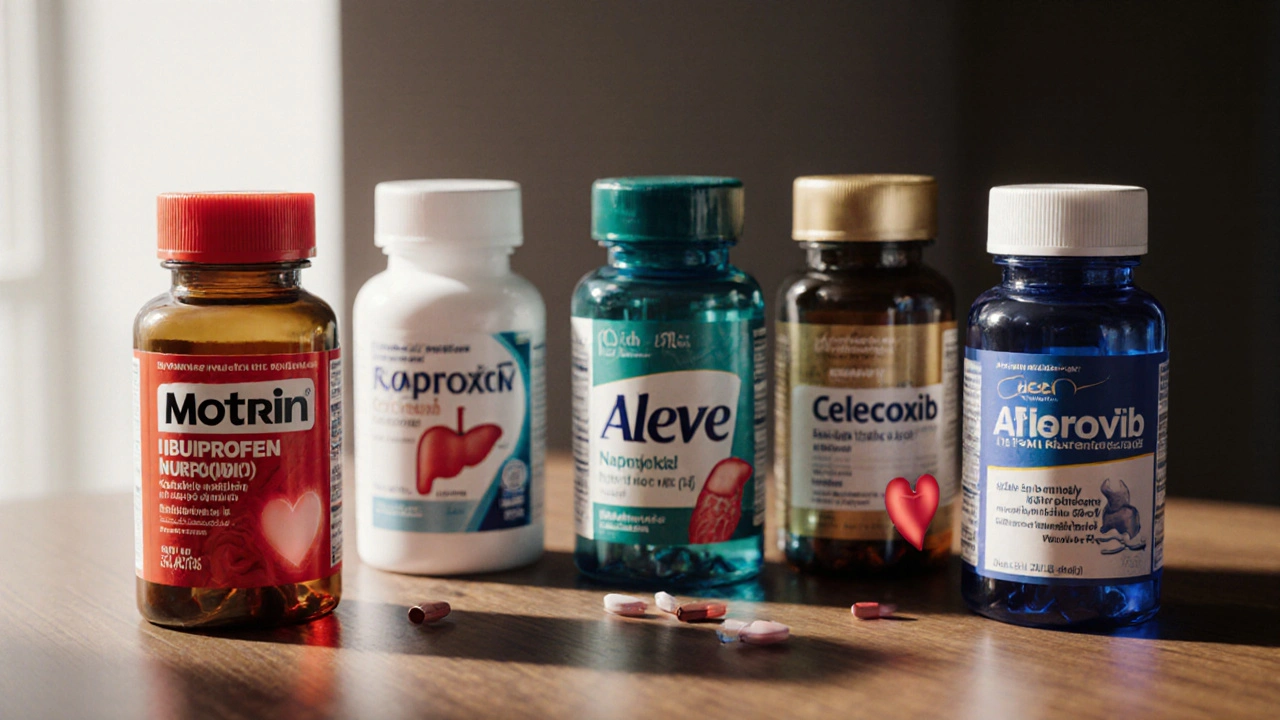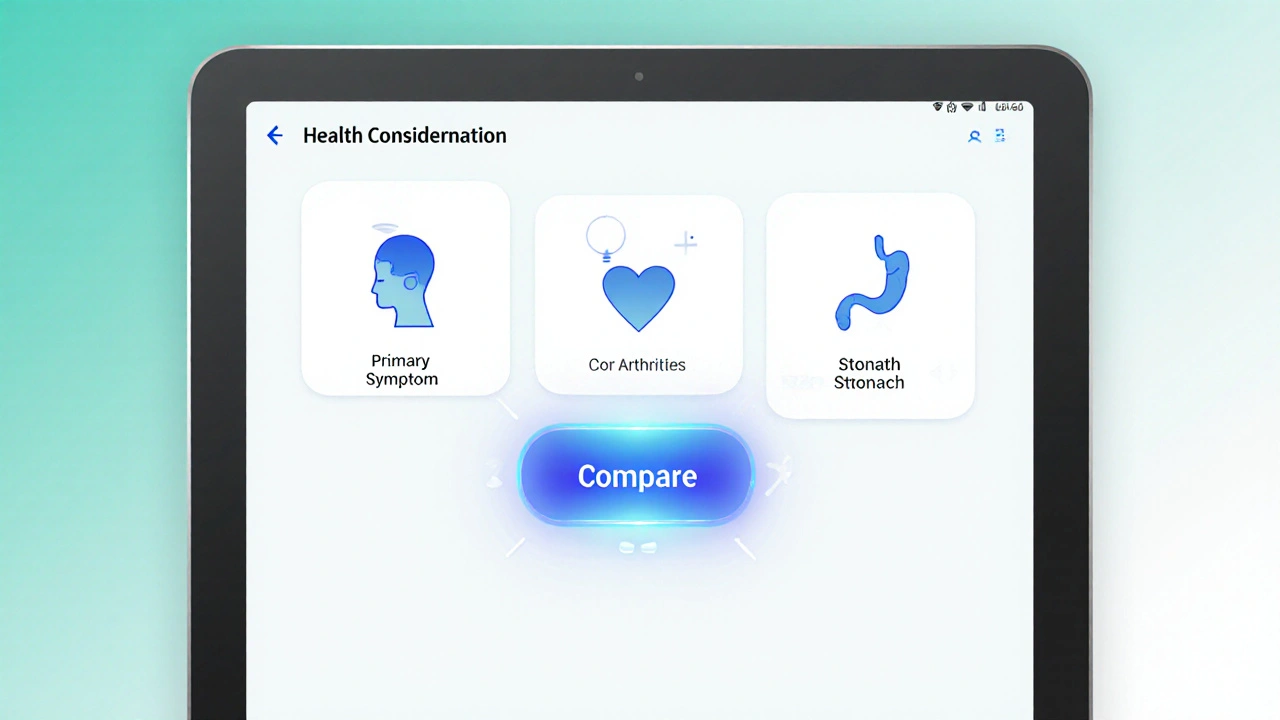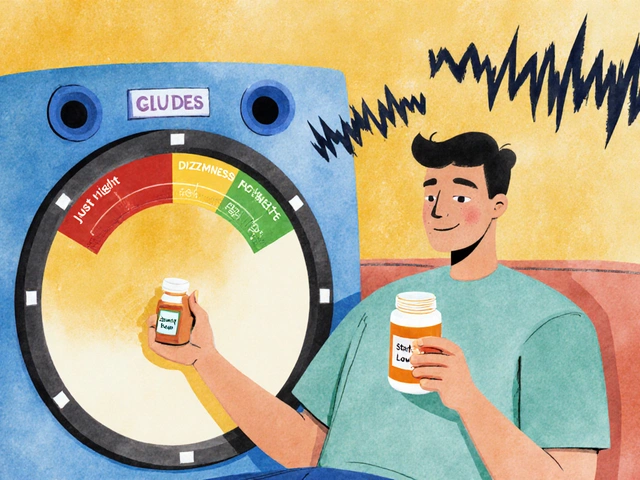Pain Relief Medication Selector
Recommended Medication:
Why This Choice:
Comparison Table:
| Medication | Active Ingredient | Duration | Anti-inflammatory | Stomach Risk |
|---|
Key Takeaways
- Motrin (ibuprofen) offers strong anti‑inflammatory action but can irritate the stomach.
- Acetaminophen (paracetamol) is gentler on the gut but lacks anti‑inflammatory benefits.
- Naproxen (Aleve) lasts longer than ibuprofen, making it better for all‑day pain.
- Aspirin works for heart‑health at low doses, yet it carries higher bleeding risk.
- Celecoxib (a COX‑2 inhibitor) targets inflammation with fewer stomach issues, but requires a prescription.
When you reach for a painkiller, the shelf is full of options. Picking the right one isn’t just about price; it’s about how the drug works, how long it lasts, and who should avoid it. This guide compares Motrin with the most common over‑the‑counter and prescription alternatives, helping you decide which medication fits your specific pain scenario.
What Is Motrin?
Motrin is a brand name for the non‑steroidal anti‑inflammatory drug (NSAID) ibuprofen. It reduces pain, fever, and inflammation by inhibiting the cyclooxygenase (COX) enzymes that produce prostaglandins, which signal inflammation and pain. Typical adult dosing is 200‑400mg every 4‑6hours, not exceeding 1,200mg per day without medical supervision.
How Ibuprofen Works
Ibuprofen blocks both COX‑1 and COX‑2 enzymes. COX‑2 suppression provides the pain‑relieving and anti‑inflammatory effects, while COX‑1 inhibition can lead to stomach irritation and affect platelet function. Understanding this balance explains why ibuprofen is effective for conditions like menstrual cramps, dental pain, and minor arthritis, but why it isn’t the best choice for people with ulcer history or kidney disease.
Common Alternatives
Below are the most frequently considered substitutes for Motrin, each with its own strengths and drawbacks.
Advil is another ibuprofen brand, marketed mainly in the United States. It shares the same active ingredient and dosing guidelines as Motrin, so its safety profile is identical.
Nurofen is the ibuprofen brand most common in the United Kingdom and Europe. It offers a range of formulations, from liquid suspensions for children to fast‑acting gels for topical use.
Aleve contains naproxen, an NSAID with a longer half‑life (≈12hours) than ibuprofen (≈2‑4hours). This means fewer doses per day but a slightly higher risk of gastrointestinal side effects.
Paracetamol (known as acetaminophen in the US) is an analgesic and antipyretic that works centrally in the brain rather than through COX inhibition. It’s gentle on the stomach but does not reduce inflammation.
Aspirin (acetylsalicylic acid) is an older NSAID that irreversibly inhibits COX‑1, providing pain relief and antiplatelet effects useful for heart‑health. Its gastrointestinal risk is higher, especially at regular analgesic doses.
Celecoxib is a prescription‑only COX‑2 selective inhibitor. It offers strong anti‑inflammatory action with a lower chance of stomach ulcers, but it may increase cardiovascular risk for some patients.

Side‑Effect Profiles at a Glance
- Stomach irritation/ulcer risk: ibuprofen, naproxen, aspirin > celecoxib > paracetamol.
- Kidney impact: all NSAIDs can reduce renal blood flow; avoid high doses if you have kidney disease.
- Bleeding tendency: aspirin (especially low‑dose) and ibuprofen affect platelet function; celecoxib has minimal impact.
- Liver safety: paracetamol is metabolized by the liver; exceeding 4g/day can cause serious liver injury.
Comparison Table
| Brand / Generic | Active Ingredient | Typical Adult Dose | Duration of Action | Anti‑Inflammatory? | OTC Availability (US/UK) | Common Side Effects |
|---|---|---|---|---|---|---|
| Motrin / Advil | Ibuprofen | 200‑400mg q4‑6h (max 1,200mg OTC) | 4‑6h | Yes | OTC US & UK | Stomach upset, headache, mild kidney impact |
| Nurofen | Ibuprofen | 200‑400mg q4‑6h | 4‑6h | Yes | OTC UK | Same as Motrin |
| Aleve | Naproxen | 220‑440mg q8‑12h (max 660mg OTC) | 8‑12h | Yes, slightly stronger | OTC US & UK | Stomach irritation, heartburn, rare kidney issues |
| Paracetamol | Acetaminophen | 500‑1,000mg q4‑6h (max 4g) | 4‑6h | No | OTC US & UK | Liver toxicity at high doses, rash |
| Aspirin | Acetylsalicylic Acid | 325‑650mg q4‑6h | 4‑6h | Weak | OTC US & UK (low‑dose 81mg prescription‑only) | Stomach ulcer, bleeding, tinnitus at high dose |
| Celecoxib | Celecoxib | 200mg q12h (prescription) | 12‑24h | Strong | Prescription only | Cardiovascular risk, mild stomach upset |
Which Option Fits Your Situation?
Headache or fever: If you need quick relief without worrying about inflammation, paracetamol is a safe first choice, especially for people with sensitive stomachs.
Muscle aches, menstrual cramps, or dental pain: Ibuprofen (Motrin/Advil/Nurofen) provides both pain relief and anti‑inflammatory action, making it ideal for these conditions.
Long‑lasting joint pain (e.g., arthritis): Naproxen (Aleve) can keep symptoms at bay with twice‑daily dosing, reducing the need for multiple pills.
Heart‑health considerations: Low‑dose aspirin may be recommended by doctors for cardiovascular protection, but for pain relief it’s not the best option due to bleeding risk.
History of stomach ulcers or gastrointestinal bleeding: Celecoxib offers inflammation control with a lower ulcer risk, though it requires a prescription and monitoring for heart health.
Kids and teens: Pediatric formulations of ibuprofen (often under the Nurofen or Motrin brand) are approved for ages 6 months and up, while paracetamol is universally safe for younger children.
Safety Tips and When to See a Doctor
- Never exceed the maximum daily dose listed on the label.
- Avoid taking ibuprofen or naproxen with alcohol, as it heightens stomach bleeding risk.
- If you have chronic kidney disease, heart failure, or are on blood thinners, consult a healthcare professional before using NSAIDs.
- Watch for signs of liver injury when using paracetamol: dark urine, yellowing skin, or persistent nausea.
- Seek medical advice if pain persists beyond three days or is accompanied by fever, swelling, or unexplained weight loss.
Frequently Asked Questions
Can I take ibuprofen and paracetamol together?
Yes, alternating ibuprofen and paracetamol can provide stronger pain control while staying within safe dose limits. Keep a 4‑hour gap between doses and never exceed the daily maximum for each.
Is Motrin safe during pregnancy?
Ibuprofen is generally avoided in the third trimester because it can affect the baby's heart and reduce amniotic fluid. In early pregnancy, discuss any pain medication with your obstetrician.
Why does ibuprofen sometimes cause stomach pain?
Ibuprofen blocks COX‑1, an enzyme that protects the stomach lining. Without this protection, stomach acid can irritate the mucosa, leading to pain or ulcers.
Can I use naproxen if I’m already on a blood thinner?
Both naproxen and ibuprofen increase bleeding risk, so combining them with anticoagulants should be done only under medical supervision.
What should I do if I accidentally exceed the paracetamol dose?
Contact emergency services or a poison control centre immediately. Early treatment with N‑acetylcysteine can prevent serious liver damage.
Choosing a pain reliever is a balance of effectiveness, safety, and personal health history. Use this comparison as a roadmap, but always consult a pharmacist or doctor when in doubt.







joni darmawan
October 5, 2025 AT 01:23 AMWhen considering any analgesic, it's crucial to weigh the pharmacodynamic profile against individual comorbidities. Ibuprofen's COX inhibition provides both analgesia and anti‑inflammatory effects, yet its gastric irritation potential cannot be ignored. For patients with a history of ulcer disease, alternative pathways become relevant. Balancing efficacy and safety is the hallmark of good clinical judgment.
Richard Gerhart
October 7, 2025 AT 08:56 AMHey folks, just wanted to say that if you're dealing with a sore muscle, ibuprofen usually does the trick. It's cheap, works fast, and you can take it with food to cut down the stomach ache. Dont forget to stay within the max daily dose, though!
Kim M
October 9, 2025 AT 16:30 PM🔍 Ever notice how the pharma giants push ibuprofen while hiding the long‑term kidney risks? 🤔 They want you to think it's just a harmless over‑the‑counter pill, but the data says otherwise. Stay woke!
Martin Gilmore
October 12, 2025 AT 00:03 AMWow!!! This guide!!! is sooo helpful!!!! But!!! why does everyone ignore the fact that NSAIDs can cause heart problems!!!?!! Pay attention!!!
jana caylor
October 14, 2025 AT 07:36 AMGreat rundown! I appreciate the clear table-makes picking a pain reliever less confusing. The side‑effect summary is especially useful for those of us juggling multiple meds.
Vijendra Malhotra
October 16, 2025 AT 15:10 PMAdding a cultural twist-many Asian markets label ibuprofen with lower dose tablets, which can help reduce stomach upset. However, the packaging often lacks proper warnings about renal strain, so consumers should stay informed.
Miriam Bresticker
October 18, 2025 AT 22:43 PMI think the best thing to remember is that every med has a trade‑off 😊. For example, while paracetamol is gentle on the tummy, over‑dosing can lead to liver damage 😬. Keep an eye on total daily intake!
Claire Willett
October 21, 2025 AT 06:16 AMProtocol aligns: NSAID = COX‑inhibitor; consider GI risk profile before Rx.
olivia guerrero
October 23, 2025 AT 13:50 PMThis info is gold!!! So many people don't realize that naproxen lasts twice as long, which means fewer pills!!! Remember to check interactions!!!
Dominique Jacobs
October 25, 2025 AT 21:23 PMI love how you highlighted the dosing intervals-makes adherence easier for busy folks. Pairing ibuprofen with a short‑acting antacid can also mitigate GI irritation, which is a practical tip for real‑world use.
Claire Kondash
October 28, 2025 AT 03:56 AMChoosing a painkiller feels like navigating a maze of trade‑offs, each with its own set of subtle nuances that most readers overlook. First, remember that ibuprofen’s anti‑inflammatory strength is valuable for musculoskeletal injuries, yet its COX‑1 inhibition can erode the protective mucus lining of the stomach. Second, the duration of action matters: while naproxen provides 8‑12 hours of relief, ibuprofen requires more frequent dosing, which can increase cumulative exposure. Third, individual health histories-such as prior ulcer disease, chronic kidney disease, or cardiovascular risk-should steer the decision toward agents with a more favorable safety profile. Fourth, the role of combination therapy should not be dismissed; alternating ibuprofen with acetaminophen can achieve superior analgesia while staying within safe daily limits. Fifth, the importance of food intake cannot be overstated; taking ibuprofen with meals or milk can blunt gastric irritation but does not eliminate it entirely. Sixth, many over‑the‑counter formulations now include gastro‑protective agents like calcium carbonate, yet those are not a panacea for high‑risk patients. Seventh, the impact of alcohol consumption is a hidden hazard, especially when mixed with NSAIDs, as it synergistically heightens bleeding risk. Eighth, the pediatric population requires age‑appropriate dosing, and liquid ibuprofen preparations have been formulated to ease administration. Ninth, pregnant users should avoid ibuprofen in the third trimester because it can affect fetal circulation and amniotic fluid volume. Tenth, patients on anticoagulants should be cautious, as ibuprofen can potentiate bleeding tendencies even though its effect is reversible. Eleventh, the pharmacogenomic landscape suggests that genetic variations in CYP2C9 may alter ibuprofen metabolism, leading to either sub‑therapeutic effects or toxicity. Twelfth, the cost factor should not be ignored; generic ibuprofen remains inexpensive, whereas prescription‑only COX‑2 inhibitors like celecoxib may pose financial barriers. Thirteenth, insurance coverage often dictates accessibility, shaping real‑world choices beyond pure efficacy. Fourteenth, the evolving evidence on cardiovascular safety of NSAIDs underscores the need for individualized risk assessment. Finally, patient education-providing clear guidance on maximum daily doses, warning signs of adverse effects, and when to seek medical advice-remains the cornerstone of safe analgesic use.
Matt Tait
October 30, 2025 AT 11:30 AMHonestly, most of this feels like marketing copy rather than evidence‑based guidance.
Benton Myers
November 1, 2025 AT 19:03 PMThat's a solid point; I'd add that taking ibuprofen with food doesn't completely eliminate gastric risk, especially for high‑dose regimens.
Pat Mills
November 4, 2025 AT 02:36 AMListen up, nation! The truth about NSAIDs has been buried beneath layers of corporate propaganda, and it's time we rise! These over‑the‑counter pills promise quick relief, yet they conceal a hidden arsenal of side effects ready to strike the unsuspecting consumer! From silent kidney damage to stealthy stomach ulcers, the risks are real and often downplayed! Don't be a pawn in the pharma game-demand transparent labeling, seek alternatives when appropriate, and never ignore warning signs! Your health is worth more than a cheap price tag!
neethu Sreenivas
November 6, 2025 AT 10:10 AMI understand the anxiety around choosing a medication when you have a sensitive stomach. It can feel overwhelming, but remember that a low‑dose celecoxib prescription might be the compromise you need. Discussing options with a pharmacist can also reveal OTC alternatives that include protective agents. In the end, a personalized approach is key.
Keli Richards
November 8, 2025 AT 17:43 PMThank you for the comprehensive overview. It will certainly aid many in making informed decisions regarding pain management.
Ravikumar Padala
November 11, 2025 AT 01:16 AMMeh, the article is okay, but it could have used more real‑world examples to illustrate the points.
King Shayne I
November 13, 2025 AT 08:50 AMWhile the guide is helpful, it fails to address the socioeconomic barriers that limit access to prescription options like celecoxib.
jennifer jackson
November 15, 2025 AT 16:23 PMGreat summary, very useful!
Brenda Martinez
November 17, 2025 AT 23:56 PMDo not be fooled by the sleek packaging of over‑the‑counter pills; they conceal a hidden arsenal of side effects ready to strike the unsuspecting consumer!